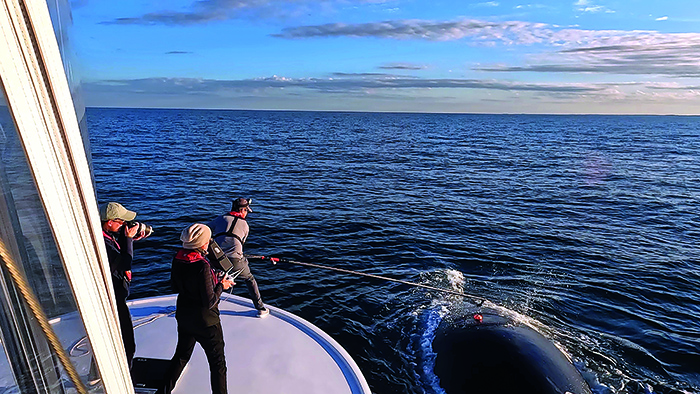Advertisement
A $5 million appropriation for near real-time tracking of endangered North American right whales was the top priority a coalition of boating interests.

Researchers carefully deploy a suction cup tag capable of collecting high-resolution behavioral data on an adult female North Atlantic right whale during her southern migration to Florida calving grounds. The tag will fall off or cease transmitting in days to weeks. Courtesy, NOAA
A $5 million appropriation for near real-time tracking of endangered North American right whales was the top priority a coalition of boating interests brought to the American Boating Congress in Washington, D.C. The annual event, held each May, brings together recreational boating interests, including BoatU.S., and federal legislators – this year including senators Joe Manchin (D-WV) and John Boozman (R-AR), co-chairs of the Congressional Sportsmen’s Caucus.
The whale tracking idea is a response to a controversial NOAA Fisheries-proposed change to existing vessel speed regulations to “further reduce the likelihood of mortalities and serious injuries” to whales from vessel collisions, which, along with commercial fishing gear entanglements, are the leading causes of whale deaths, according to NOAA’s ongoing Unusual Mortality Event study. There are fewer than 340 North Atlantic right whales, according to NOAA, which includes fewer than 100 reproductively active females.
In August 2022, NOAA proposed key changes that would affect more boats, including broadening the 10-knot (11.5 mph) restriction to boats beginning at 35 feet, which includes more recreational boats; and expand the seasonal speed zones from 10 localized zones located along the coast from Maine to Florida to essentially the entire Eastern Seaboard.
NOAA proposed key changes that would broaden the 10-knot restriction to boats beginning at 35 feet
The Whale and Vessel Safety Task Force, or WAVS, is a new coalition of marine industry and marine technology companies created to develop technical solutions, citing an economic anchor to the offshore marine industry and lifestyle, as well as boater safety. The coalition includes offshore sportfishing groups and the National Marine Manufacturers Association (NMMA). Members assert that NOAA’s proposed remedy is overreach, putting offshore recreational boats in danger should they need to outrun unexpected storms offshore; NOAA says the speed limit would not be enforced in gale force winds (greater than 34 knots). The group also questions the inclusion of recreational boats with commercial vessels, which are statistically more prone to whale strikes by their sheer numbers, deeper draft, and hours on the water.
North Atlantic right whales were originally listed as endangered in 1973 under the Endangered Species Act. But the documented population of right whales has been in decline since the late 1990s. NOAA’s first speed rule went into effect in 2008, requiring most vessels 65 feet and larger transit at speeds of 10 knots or less in designated right whale Seasonal Management Areas. Since then, NOAA cites 12 right whale serious injury and mortality events involving vessel collisions in U.S. waters. Five of those were attributed to vessels less than 65 feet.
The industry’s technical proposals will require additional funding and NOAA approval to tag whales – which currently is prohibited. NOAA already tags and tracks some North Atlantic right whales but reports that the transponders last only a matter of days or weeks before they fall off or cease transmitting.
While no fully developed products have been proposed, the WAVS group says some off-the-shelf products could be modified to become an aid to avoid whale strikes.
“The idea is to use technology – whether that involves sonar, coordinating sophisticated multi-radar tracking algorithms, or tagging each of the most appropriate surviving whales over time,” says John DePersenaire, WAVS member and government affairs director for the Viking Yacht Company, which builds offshore sportfishing yachts ranging from 37 to 92 feet.
In support of the marine industry and offshore boaters, senators Manchin and Boozman introduced the “Protecting Whales, Human Safety, and the Economy Act of 2023” in June to prohibit NOAA from issuing a rule that modifies or replaces the current regulation until “mitigation protocols are fully developed and deployed.” In a joint statement, Boozman added, “We can and should balance protecting wildlife and livelihoods because it is common sense.”
The bill does not include any funding for WAVS’ proposal. BoatU.S. Magazine is keeping track of the bill’s progress.
After NOAA finishes reviewing some 90,000 public comments, its final ruling could come at any time as this issue goes to press. Regardless of its decision, litigation threatened by the sportfishing organizations and other parties is likely to keep any new rules tied up for many months.
